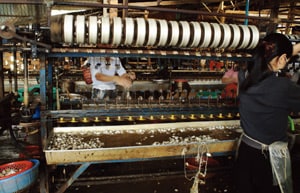ANALYSIS — ASIA’S EXPORTERS
By Thomas Clouse
Asia’s exporters are all benefiting as China’s manufacturers begin to move up the value chain.
The Asian economic miracle is hardly a new story, but every once in a while, a new actor steps into center stage. In the post–World War II era, Japan rose rapidly to become the region’s largest economy and the second largest economy in the world. During that process, the drivers of its growth evolved from simple manufacturing to development of the world’s most sophisticated technological products. South Korea, Taiwan, Singapore and Hong Kong followed similar tracks, drastically boosting GDP while creating some of world’s most innovative products and successful companies.
Following in the steps of Japan and the four Asian tigers, China has moved into the limelight over the past decade. As skill levels and wages in its more developed neighbors rose, China and its huge population soaked up investment in low-end, labor-intensive manufacturing. In 2000, foreign direct investment in China totaled just over $40 billion. By 2008, it had grown to $108 billion. This investment had a profound impact on the economy, with foreign-invested companies accounting for almost 56% of the total value of the country’s exports last year. In current US dollar terms, China’s GDP more than quadrupled in the decade from 2000 to 2009. By some estimates, its economy has already overtaken Japan to become the world’s second largest.
China’s popularity as a destination for foreign direct investment remained high last year, even in the face of a worldwide financial crisis. Global flows of FDI decreased by 44% from 2008 to 2009, according to Unctad. China’s FDI inflows fell only 12% to $95 billion. During the same period FDI inflows to the US, the world’s largest FDI destination, fell by more than half from $316 billion to only $130 billion. Momentum in China has picked up again this year, according to the country’s finance ministry, with FDI up by more than 18% year-on-year in the first half of 2010.
The popularity of manufacturing in China has helped to boost wages, especially in areas traditionally known for export production. Employees, emboldened by a new labor law passed in 2008, are demanding—and in many cases getting—better working conditions and wages. After a highly publicized walkout at one of its key component suppliers, Japanese carmaker Honda agreed to a 21% increase in wages. Taiwan-based laptop maker Hon Hai raised wages by 30% after several worker suicides at one of its affiliate’s production facilities.
In the past, the Chinese government played down displays of worker discontent to avoid scaring away foreign investors. These recent stories of strikes and suicides have received much publicity, however, indicating implicit government approval. Authorities are increasingly enforcing the country’s labor law, after only loosely applying it last year as export growth slowed.
Carl Berrisford, APAC equity research analyst for UBS Wealth Management, explains: “China’s growth model has been based to a large degree on low-value exports, taking advantage of its cheap and very abundant labor force. The model is maturing. Labor costs are going up, and it is something that the government is behind as well.”
As China’s market matures, many investors are looking to the country’s less developed neighbors for low-cost manufacturing. “In the last two months especially, since we heard the news on these wage hikes [affecting] foreign investors in automotive and electronics manufacturing, we’ve seen a renewed interest in frontier markets in Asia,” Berrisford says, “and it’s probably on the back of what’s happening in China.”
China’s economic rise may also benefit its neighbors in terms of its own direct investments abroad. China’s outbound FDI totaled $43.3 billion last year, a year-on-year increase of 6.5%. Considering that overall FDI flows plunged by almost half, China’s modest gain demonstrates the strength of its buying power. According to a survey conducted by the China Council for the Promotion of International Trade and published in April, Chinese companies made more than 30% of their foreign investments in Asia last year, making the region its most popular FDI destination.
John Bender, managing director of Bender Consulting, describes China’s goals in such investments: “More than 3,000 Chinese companies have stated either regional or global ambitions. They are looking for natural resources, for access to markets for products, and for intellectual property and patents to evolve up the food chain.”
Closer to Home
While some Chinese investors are seeking out these potential investments abroad, others—including foreign companies already established in China—are finding opportunities in the country’s less developed interior, where wages remain low. The government’s $586 billion stimulus package has facilitated this trend by financing new investments in roads, railways, and airports. Bender observes: “The national infrastructure is in place or rapidly being built, so that China doesn’t have to go to India or Vietnam. Multinational and Chinese companies on the east coast can do lower-cost manufacturing in the central and western parts of the country. In a sense, China can outsource to itself.”

This movement of activity helped China’s western provinces to turn in economic growth of 13.4% last year, compared with 9.1% for the country as a whole. The trend is likely to continue this year, with domestic media reporting an increase in foreign investment of 31% year-on-year in China’s western provinces in the first half of the year. Car companies Ford and Mazda are both building new facilities in the interior municipality of Chongqing, while Foxconn announced plans in July to build a new facility in the province of Hebei.
Chandra Athukorala, professor of economics at the Australian National University, believes that China’s interior regions and neighbors all have potential to benefit from China’s rising status in the production chain. He explains: “If you are in a position to get your macro house in order and maintain your investment climate attractiveness, then China’s presence can actually improve your relative position, because China is a huge final assembler. China’s expansion in the world economy will generate opportunities for countries to get involved in component production and testing within the production chain.”

Beyond helping low-cost manufacturing areas in Asia attract investment, China’s rising wages may also open opportunities for multinational companies that want to sell to China as well as produce for global markets. Retail sales in China rose by 18.2% in the first half of the year, and urban and rural consumption rose by 18.6% and 15.6% respectively, according to the National Bureau of Statistics. The country is already the world’s largest automobile and mobile-phone market, as well as home to the world’s largest Internet population.
The government is implementing several programs to support this expansion in consumption, including increases in pension payments and unemployment benefits, subsidies for automotive and appliance purchases, waivers for educational fees and various tax exemptions. By providing such incentives, it hopes to strengthen its domestic market and thus reduce its dependence on exports.
Multinational companies looking to capitalize on this growing consumer market are likely to locate in China despite rising labor costs. “Multinational companies coming to China to produce for international markets have a big domestic market, which will help to keep the unit cost of production low,” says Athukorala.
Rising wages and consumption are only part of the Asian economic story, however. Japan, Korea, Singapore and Taiwan have also grown into leading centers for research and development, information technology and finance. While China already serves as a popular location for final assembly of many high-tech products, the country is also making efforts to increase the value of its contribution to the items it produces.
As Bender points out, some Chinese acquisitions abroad are driven by the desire for more advanced technology. Chinese computer company Lenovo pioneered this trend with its 2005 purchase of IBM’s personal computer division. This trend extends beyond high-tech companies, with Chinese carmaker Zhejiang Geely announcing last month that it had purchased Swedish automaker Volvo. The government is also recruiting foreign companies to invest in more high-technology facilities within China, offering cheap land, tax incentives and goodwill for potential business in the years to come. Microsoft is one company that has responded, building R&D; centers in Beijing and Shanghai.
 |
|
Manufacturers in countries such as Vietnam are benefiting as China’s costs rise |
This transition to higher-end manufacturing and R&D; is clearly under way, Athukorala believes, but it will take time. “China is becoming more competitive at relatively advanced stages in the production process. But I don’t see China’s relative position at the high-technology end of the production process relative to Japan and other more developed Asian countries changing in the near future, not in the next 10 to 20 years.”
Jeffrey Blount, partner-in-charge of the Hong Kong and Beijing offices of international law firm Fulbright & Jaworski, describes some of the challenges China faces in making that transition. “Giving people tax and investment incentives is only going to work to a limited extent if the domestic judicial processes and the laws and regulations don’t protect what comes out of the pipeline,” he asserts.
Blount believes, though, that the situation is gradually improving. Blount also points out that China’s policy-driven environment has some advantages. “The government has the ability to set policy and move on it,” he says. “That was one thing when China was poor, but now that liquidity is no longer an issue, they really have the ability to set, implement and make policy into reality. This is a very powerful convergence in the history of the world right now.”



